Scientific name: Dasypodidae
Class: Mammalia
Lifespan: Nine-banded armadillo: 12 – 15 years
Height: Nine-banded armadillo: 15 – 25 cm
Mass: Nine-banded armadillo: 2.5 – 6.5 kg, Giant armadillo: 19 – 33 kg
Armadillo shells are bulletproof. In fact, one Texas man was hospitalized when a bullet he shot at an armadillo ricocheted off the animal and hit him in the jaw.
They vary in size, from 5-59 inches in length to 3-120 pounds in weight. Armadillos can be pinkish, dark-brown, black, red, gray or yellowish in color. Their whole body (head, back, legs and tail) is covered with bony plates. Only three-banded armadillo can curl into the ball to protect itself from predators
.
Translated from Spanish to mean ‘little armoured one’, armadillos are the only living mammal with such a shell!Since armadillos eat insects, they are somewhat beneficial, but they can be a problem for landowners and property managers. They dig up lawns, plant beds and excavate several burrows throughout their habitat. ... Insecticides may restrict food sources, but will not always keep the armadillos from digging.
Armadillos are not blind, but they do have poor eyesight. They rely on their ears and noses more than their eyes to detect food or predators.
Six species of naked-tailed armadillos are recognized. The most familiar of these (and the most widespread of any armadillo species) is the nine-banded armadillo (D. novemcinctus). The other five are the great long-nosed armadillo (D. kappleri), the hairy long-nosed armadillo (D. pilosus), the Llanos long-nosed armadillo (D. sabanicola), the seven-banded armadillo (D. septemcinctus), and the Southern long-nosed armadillo (D. hybridus). A seventh species, Yepes's mulita (D. yepesi) has been proposed based on some specimens from the Jujuy and Salta provinces of Argentina, but to date insufficient taxonomic data exists to confirm the existence of these animals as a distinct species.
Six species of naked-tailed armadillos are recognized. The most familiar of these (and the most widespread of any armadillo species) is the nine-banded armadillo (D. novemcinctus). The other five are the great long-nosed armadillo (D. kappleri), the hairy long-nosed armadillo (D. pilosus), the Llanos long-nosed armadillo (D. sabanicola), the seven-banded armadillo (D. septemcinctus), and the Southern long-nosed armadillo (D. hybridus). A seventh species, Yepes's mulita (D. yepesi) has been proposed based on some specimens from the Jujuy and Salta provinces of Argentina, but to date insufficient taxonomic data exists to confirm the existence of these animals as a distinct species.
Dasypus novemcinctus
Nine-banded Armadillo, Long-nosed Armadillo
- Range:
- South-central and southeastern United States to Peru and Uruguay, Grenada in the Lesser Antilles, Trinidad and Tobago.
- Size and Weight:
- Head and body length: 240 — 573 mm (9.4 — 22.6 in).
Tail length: 125 — 483 mm (4.9 — 19.0 in).
Weight: 1 — 10 kg (2.2 — 22.0 lbs). - Description:
- Most members of the genus Dasypus have very little hair. Almost no hair is present on the upper part of the body, while sparsely scattered and pale yellowish hair is present on the undersides. They range from mottled brown to yellowish white in carapace color. Members of this genus are characterized by the long, pointed nose and relatively short legs. Four toes are present on the front feet, five toes on the hind feet, all with well-developed claws. Because they walk on the tips of their feet, they tend to leave three-toed tracks that resemble bird footprints. They may possess from 6 to 11 moveable bands on the shell. D. novemcinctus generally has 8 bands in northern and southern parts of its range, and 9 bands in more central areas. The ears and tail of D. novemcinctus are very long. The ears may be 40 to 50% of the length of the head, and the tail is around 70% of the length of the body.
- Habitat:
- Members of this genus appear to prefer dense shady cover and limestone formations, from sea level to 3000 meters in elevation. They dig burrows from 0.5 to 3.5 meters deep and up to 7.5 meters long. Large nests of grass or leaves are often constructed in nest chambers within the burrow. D. novemcinctus has been observed to build nests outside of burrows, in clumps of saw palmetto, resembling small haystacks. They often share burrows with other armadillos, but not with members of the opposite sex.
- Ecology:
- Armadillos in the genus Dasypus are primarily nocturnal, but occasionally forage in the daytime. They emit almost constant grunting noises while they are foraging. If they feel threatened, they hurry to a nearby burrow. If there is no burrow nearby, they curl up as much as possible to protect their soft undersides. The animals do not seem to feel threatened by humans.The diet consists primarily of animal matter, but is adaptable based on foraging conditions. In areas with little insect prey but large amounts of berries or other plant material, the nine-banded armadillo will readily switch to a more vegetarian diet. The armadillos forage for insects, spiders, and small amphibians; they predominately seem to prefer beetles and ants. They have been known to kill and eat young cottontail rabbits, and are also known to eat scraps of carrion. Although the nine-banded armadillo is often accused of eating the eggs and young of ground nesting birds such as quail, birds and their eggs make up less than 0.4% of the diet of an average armadillo. Nine-banded armadillos have a salivary bladder surrounded by skeletal muscle, unique among mammals. The salivary bladder acts as a reservoir for the thick, sticky saliva used to capture small insects. When the armadillo is feeding, the muscles around the salivary bladder contract, squeezing the stored saliva out onto the tongue.The average home range of 12 D. novemcinctus studied in Florida is 5.7 hectares (12.4 acres). Population densities in South America have been reported as high as 13 per square kilometer for D. novemcinctus. D. novemcinctus has been reported to be aggressive in high densities, and are frequently seen chasing or “boxing” one another by balancing on the hind legs and tails and striking out with the front claws. Adult males were more aggressive towards subadult males; lactating or pregnant females were aggressive towards young born the previous year.
- Biology:
- Mating in North America takes place in July and August, but implantation of the zygote is delayed until November. Females can delay implantation of fertilized eggs for up to 4 months if conditions are currently unfavorable for rearing young. The gestation period is 120 days. D. novemcinctus is unique in that four identical young are produced from a single egg, producing litters of four identical young (although occasionally only two to three or as many as six young have been found in a single litter). Young are born with their eyes open, are weaned at 4 — 5 months, and are sexually mature at about 1 year of age. Females have four mammae, one for each armadillo pup. The life span of D. novemcinctus is reported to be 12 to 15 years.D. novemcinctus is the only Xenarthran found in the United States. They are relatively recent arrivals, having expanded their range into Texas around 1880. D. novemcinctus was introduced into Florida deliberately in the 1920’s. The nine-banded armadillo has expanded its range as far northwest as Colorado, and currently is also found in Oklahoma, Missouri, Arkansas, Mississippi, Louisiana, Alabama, South Carolina and Georgia. (For more information on the armadillo expansion into the United States, please see the Armadillo Expansion page.) Members of the genus Dasypus have been present in what is now the US intermittently for about one million years. The last animal of this genus to live in central North America was D. bellus, the beautiful armadillo, during the Pleistocene era, occupying basically the same range as D. novemcinctus does today. D. bellus is considered the historical counterpart of the nine-banded armadillo, as they are identical except for size.D. novemcinctus has been accused of destroying eggs, burrowing under foundations, and crop destruction. Members of the genus Dasypus are generally considered to be ecologically important due to their destruction of unwanted insects. Many other small animals use abandoned armadillo burrows as shelter. D. novemcinctus is easily tamed, but does not appear to do well in captivity. Due to the unique production of four identical young, weak immune system and relatively low body temperatures, D. novemcinctus has proven useful as a medical research test animal for diseases such as leprosy, typhus, and trichinosis, as well as for research on multiple births, organ transplants, and birth defects. Nine-banded armadillos carry relatively few parasites, despite the lack of a strong immune response. D. novemcinctus is particularly noted for its susceptibility to leprosy, both in laboratories and in the wild. D. novemcinctus is the most common armadillo held in zoos, especially in the US.
- Pictures:
-
Do you have a picture of D. novemcinctus that you would like to donate to this site? Please see the Armadillos Wanted page to see how you can help.
- Anatomical Images:
-
Anatomical specimens hosted by and © BrainMuseum.org and University of Michigan Museum of Zoology Animal Diversity Web; linked with permission.
- Movies:
-
Movies hosted by and © University of Michigan Museum of Zoology Animal Diversity Web; linked with permission. Quicktime plugin required.
Dasypus kappleri
Great Long-nosed Armadillo
- Range:
- East of the Andes from Colombia and northern Bolivia to the Guianas and northeastern Brazil.
- Size and Weight:
- Head and body length: 240 — 573 mm (9.4 — 22.5 in).
Tail length: 125 — 483 mm (4.9 — 19.0 in).
Weight: 1 — 10 kg (2.2 — 22.0 lbs). - Description:
- Most members of the genus Dasypus have very little hair. Almost no hair is present on the upper part of the body, while sparsely scattered and pale yellowish hair is present on the undersides. They range from mottled brown to yellowish white in carapace color. Members of this genus are characterized by the long, pointed nose and relatively short legs. Four toes are present on the front feet, five toes on the hind feet, all with well-developed claws. They may possess from 6 to 11 movable bands on the shell. D. kappleri has two to three rows of bony scutes on the knees, a trait not seen in other members of the genus Dasypus.
- Habitat:
- Members of this genus appear to prefer dense shady cover and limestone formations, from sea level to 3000 meters in elevation. They dig burrows from 0.5 to 3.5 meters deep and up to 7.5 meters long. Large nests of grass or leaves are often constructed in nest chambers within the burrow. They often share burrows with other armadillos, but not with members of the opposite sex.
- Ecology:
- Armadillos in the genus Dasypus are primarily nocturnal, but occasionally forage in the daytime. They emit almost constant grunting noises while they are foraging. If they feel threatened, they hurry to a nearby burrow. If there is no burrow nearby, they curl up as much as possible to protect their soft undersides. The animals do not seem to feel threatened by humans. The diet consists primarily of animal matter. The armadillos forage for insects, spiders, and small amphibians; they predominately seem to prefer beetles and ants.
- Biology:
- D. kappleri produces 2 — 12 young per litter.
- Pictures:
- (No picture available for D. kappleri.)Do you have a picture of D. kappleri that you would like to donate to this site? Please see the Armadillos Wanted page to see how you can help.
Dasypus pilosus
Hairy Long-nosed Armadillo
- Range:
- Found only in mountains of southwestern Peru.
- Size and Weight:
- Head and body length: 240 — 573 mm (9.4 — 22.6 in).
Tail length: 125 — 483 mm (4.9 — 19.0 in).
Weight: 1 — 10 kg (2.2 — 22.0 lbs). - Description:
- Although most members of the genus Dasypus have very little hair, the hairy long-nosed armadillo is an exception to this rule. Almost no hair is present on the head, but long white and pale yellowish hair is present on the shell and undersides, giving this animal a distinctly furry appearance. They range from mottled brown to yellowish white in carapace color. Members of this genus are characterized by the long, pointed nose and relatively short legs. Four toes are present on the front feet, five toes on the hind feet, all with well-developed claws. They generally have 11 movable bands on the shell.
- Habitat:
- Members of this genus appear to prefer dense shady cover and limestone formations, from sea level to 3000 meters in elevation. They dig burrows from 0.5 to 3.5 meters deep and up to 7.5 meters long. Large nests of grass or leaves are often constructed in nest chambers within the burrow. They often share burrows with other armadillos, but not with members of the opposite sex.
- Ecology:
- Armadillos in the genus Dasypus are primarily nocturnal, but occasionally forage in the daytime. They emit almost constant grunting noises while they are foraging. If they feel threatened, they hurry to a nearby burrow. If there is no burrow nearby, they curl up as much as possible to protect their soft undersides. The animals do not seem to feel threatened by humans. The diet consists primarily of animal matter. The armadillos forage for insects, spiders, and small amphibians; they predominately seem to prefer beetles and ants.
- Biology:
- D. pilosus is listed as vulnerable by the IUCN, but other species in the genus Dasypus may be increasing in number. The hairy long-nosed armadillo is a protected species in Peru.
- Pictures:
-
A photo of the hairy long-nosed armadillo may be found on the National Geographic Wild World website.
- Hairy long-nosed armadillo photo from the National Geographic website
Do you have a picture of D. pilosus that you would like to donate to this site? Please see the Armadillos Wanted page to see how you can help.
Dasypus sabanicola
Llanos Long-nosed Armadillo
- Range:
- Llanos of Colombia and Venezuela.
- Size and Weight:
- Head and body length: 240 — 573 mm (9.4 — 22.5 in).
Tail length: 125 — 483 mm (4.9 — 19.0 in).
Weight: 1 — 10 kg (2.2 — 22.0 lbs). - Description:
- Most members of the genus Dasypus have very little hair. Almost no hair is present on the upper part of the body, while sparsely scattered and pale yellowish hair is present on the undersides. They range from mottled brown to yellowish white in carapace color. Members of this genus are characterized by the long, pointed nose and relatively short legs. Four toes are present on the front feet, five toes on the hind feet, all with well-developed claws. They may possess from 6 to 11 movable bands on the shell. The ears of D. sabanicola are shorter than the ears of D. novemcinctus.
- Habitat:
- Members of this genus appear to prefer dense shady cover and limestone formations, from sea level to 3000 meters in elevation. They dig burrows from 0.5 to 3.5 meters deep and up to 7.5 meters long. Large nests of grass or leaves are often constructed in nest chambers within the burrow. They often share burrows with other armadillos, but not with members of the opposite sex.
- Ecology:
- Armadillos in the genus Dasypus are primarily nocturnal, but occasionally forage in the daytime. They emit almost constant grunting noises while they are foraging. If they feel threatened, they hurry to a nearby burrow. If there is no burrow nearby, they curl up as much as possible to protect their soft undersides. The animals do not seem to feel threatened by humans. The diet consists primarily of animal matter. The armadillos forage for insects, spiders, and small amphibians; they predominately seem to prefer beetles and ants. Population densities in South America have been reported as high as 280 per square kilometer for D. sabanicola.
- Biology:
- D. sabanicola bears 4 young per litter.
- Pictures:
- (No picture available for D. sabanicola.)The mammalogy.org website has a photo of a Llanos long-nosed armadillo.
- Llanos Long-nosed Armadillo photo on the mammalogy.org website
Do you have a picture of D. sabanicola that you would like to donate to this site? Please see the Armadillos Wanted page to see how you can help.
Dasypus septemcinctus
Seven-banded Armadillo
- Range:
- Eastern and southern Brazil, eastern Bolivia, Paraguay, extreme northern Argentina.
- Size and Weight:
- Head and body length: 240 — 573 mm (9.4 — 22.5 in).
Tail length: 125 — 483 mm (4.9 — 19.0 in).
Weight: 1 — 10 kg (2.2 — 22.0 lbs). - Description:
- Most members of the genus Dasypus have very little hair. Almost no hair is present on the upper part of the body, while sparsely scattered and pale yellowish hair is present on the undersides. They range from mottled brown to yellowish white in carapace color. Members of this genus are characterized by the long, pointed nose and relatively short legs. Four toes are present on the front feet, five toes on the hind feet, all with well-developed claws. They generally have 6 or 7 movable bands on the shell.
- Habitat:
- Members of this genus appear to prefer dense shady cover and limestone formations, from sea level to 3000 meters in elevation. They dig burrows from 0.5 to 3.5 meters deep and up to 7.5 meters long. Large nests of grass or leaves are often constructed in nest chambers within the burrow. They often share burrows with other armadillos, but not with members of the opposite sex.
- Ecology:
- Armadillos in the genus Dasypus are primarily nocturnal, but occasionally forage in the daytime. They emit almost constant grunting noises while they are foraging. If they feel threatened, they hurry to a nearby burrow. If there is no burrow nearby, they curl up as much as possible to protect their soft undersides. The animals do not seem to feel threatened by humans. The diet consists primarily of animal matter. The armadillos forage for insects, spiders, and small amphibians; they predominately seem to prefer beetles and ants.
- Biology:
- D. septemcinctus may have 4 — 8 young per litter.
- Pictures:
-
Do you have a picture of D. septemcinctus that you would like to donate to this site? Please see the Armadillos Wanted page to see how you can help.
Dasypus hybridus
Southern Long-nosed Armadillo
- Range:
- Paraguay, northern and central Argentina, Uruguay, southern Brazil.
- Size and Weight:
- Head and body length: 240 — 573 mm (9.4 — 22.5 in).
Tail length: 125 — 483 mm (4.9 — 19.0 in).
Weight: 1 — 10 kg (2.2 — 22.0 lbs). - Description:
- Most members of the genus Dasypus have very little hair. Almost no hair is present on the upper part of the body, while sparsely scattered and pale yellowish hair is present on the undersides. They range from mottled brown to yellowish white in carapace color. Members of this genus are characterized by the long, pointed nose and relatively short legs. Four toes are present on the front feet, five toes on the hind feet, all with well-developed claws. They generally have 6 or 7 movable bands on the shell. The ears of D. hybridus are shorter than the ears of D. novemcinctus.
- Habitat:
- Members of this genus appear to prefer dense shady cover and limestone formations, from sea level to 3000 meters in elevation. They dig burrows from 0.5 to 3.5 meters deep and up to 7.5 meters long. Large nests of grass or leaves are often constructed in nest chambers within the burrow. They often share burrows with other armadillos, but not with members of the opposite sex.
- Ecology:
- Armadillos in the genus Dasypus are primarily nocturnal, but occasionally forage in the daytime. They emit almost constant grunting noises while they are foraging. If they feel threatened, they hurry to a nearby burrow. If there is no burrow nearby, they curl up as much as possible to protect their soft undersides. The animals do not seem to feel threatened by humans. The diet consists primarily of animal matter. The armadillos forage for insects, spiders, and small amphibians; they predominately seem to prefer beetles and ants.
- Biology:
- In D. hybridus, implantation of the zygote occurs in June, and young are born in October, 4 — 12 young per litter.
- Pictures:
-
Do you have a picture of D. hybridus that you would like to donate to this site? Please see the Armadillos Wanted page to see how you can help.
Sources
McBee, K. and Baker, R.J. 1982. Dasypus novemcinctus. Mammalian Species 162: 1-9.
Nowak, R.M. 1999. Walker’s Mammals of the World, 6th edition. Johns Hopkins University Press, Baltimore, MD. 158-168.
Additional references listed on the Sources and Credits page.
Abbreviations
IUCN: International Union for Conservation of Nature and Natural Resources
USDI: United States Department of the Interior
CITES: Convention on International Trade in Endangered Species of Wild Fauna and Flora



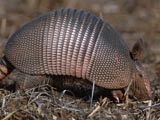
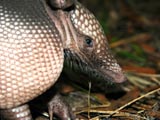

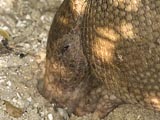
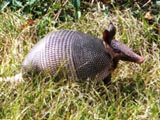
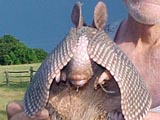

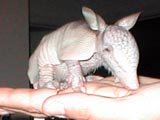
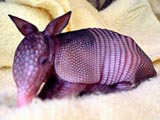

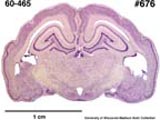
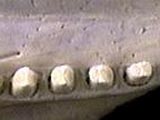

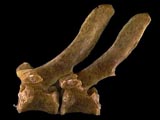
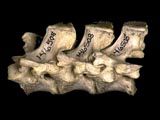
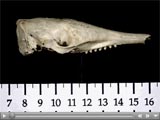

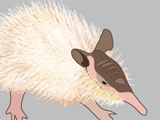
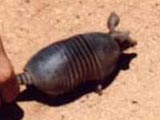


No comments:
Post a Comment